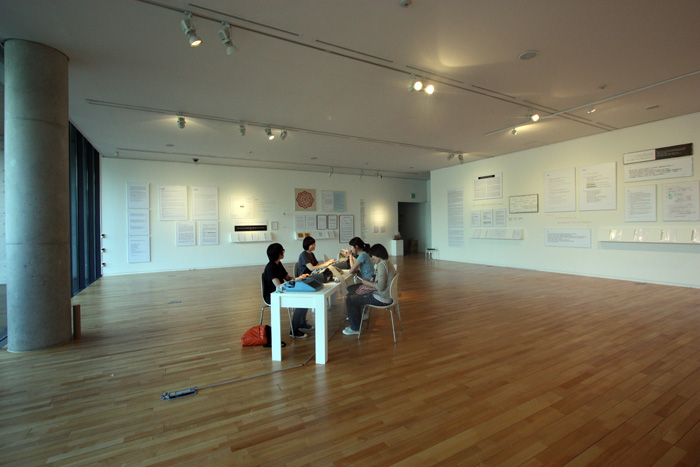Exhibition Preface_ 6th Solo Show-Dialogue/Yoonjung Park (ENG)


Dialogue
by Younjeong Park, Chief Curator of SOMA
A dialogue may encompass a conversation, a monologue, an aside, or even silence, but corresponds especially to a monologue. A dialogue, which has the Greek origin dialogos, is a conversation between two or more people.
Hyesoo Park’s solo exhibition features life stories, confessions, and conversations about life. The exhibition venue is filled with the voice of egos, alongside overheard stories, the artist’s questions and answers, unquestioned questions, unheard replies, mental images replaced with music, and the audiences’ narratives, represented by typewriters.
Hyesoo Park’s solo exhibition features life stories, confessions, and conversations about life. The exhibition venue is filled with the voice of egos, alongside overheard stories, the artist’s questions and answers, unquestioned questions, unheard replies, mental images replaced with music, and the audiences’ narratives, represented by typewriters.
Overheard Conversations
A collection of dialogues, written like the lines of a play, after eavesdropping an others’ conversations, is an abridged history of the lives of 50 people. The Dialogue Project, capturing dialogue between people Park randomly selected over four months, contains this exhibition’s crucial element. Through it, the artist makes this confession: “Their dialogues speak of a meaning of life I haven’t known, and a world I never want to know, and refuse to be true. Park heals herself, and matures through this collection of dialogues, and now wants to speak of her experience. Her significant questioning of the trivial can be identified in dialogue No.36, which ends with the question, “Why do people hate serious talk?” As I read her collection of dialogues, I could not shake the uneasy feeling in my mind.
The Others’ Replies
The artist shows a record of 50 dialogues involving 100 people of various occupations, and asks them to choose one, then describe their feelings – based on their professional expertise and life experience - after reading it. She then enlarges and frames the result of this process and displays it on a wall. Viewers might then feel relieved when they also read a quotation from novelist Oaesoo Lee, “That we cannot light a cigarette with the sun is not the sun’s fault.” They might also react negatively to a feminist activist’s cynical, self-mocking allusion to her own inability to form a home, caused by original sin. To speak with slight exaggeration, in response to her work, viewer’s may even experience a state in which they want to ask her to tell their fortune, after reading all their statements and dialogues, while expressing sympathy for them. To this, viewer’s can make their own statements with typewriters. And so, the purpose of this exhibition seems to be to let viewers realize people are thirsting for conversation, and wish earnestly to find someone who understands them.
The Tomb of Text and Dance Music
We sometimes experience the unintentional murmuring of something through vacant eyes. Such a murmuring can be true, though we experience it through a shattered mind. The tomb of fragmented texts is a metaphor for scattered answers to unasked questions. With it, Park represents an aspect of suicide, resulting from a false story, presented as something authentic and real. Whether the fragmented text she uses is true or false, it seems to be a warning against ones that claim to proceed what they do. Over the windows of the room is a chair-like installation, while Aram Khachaturian’s Sabre Dance and Saint-Saens’ Dance Macabre, recommendations by television personality Inyong Hwang to alienated, aged people, resonates through a speaker hung on a three-meter pole. The powerful dance music to comfort their lonesome winter of life, instead of the requiem associated with their conversation.
Commencement
A log, about 15 cm high and 45 cm wide, can be found in Hyesoo Park’s studio. Since 1998, for two years, Park burnt its inner-rings with a magnifying-glass, gathering sunlight into one place. When I first saw this work I felt her sincerity, and thus a positive expectation for her future. In a series of her work, dialogues with other things, such as stone, tree, pollen, and plants move into multi-channel conversations with men. Park reaches insights into objects when focusing on only one, and so expands her perspective toward its surroundings. She also conceives this sunlight drawing through her sturdy, thorough, and obstinate exploration, and notes what others might say.
This moment flows to become part of the past. One’s eye reading this essay belongs to the past, leaving the trace of time. The remains within it are floating words or images left in our mind as positive or negative prints. Estranged from images, such words are often in collusion with absurd images. In this situation, how can we separate the chaff from the grain? It is often the case that we hear only what we want to hear. In this situation it might be foolish to assert that the truth can be understood. The artist seems to know this point.








